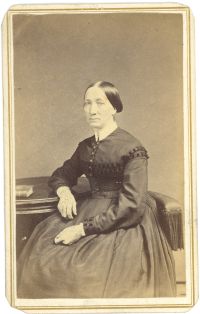The following article was originally written by Lorine McGinnis Schulze and published on Olive Tree Genealogy at http://www.olivetreegenealogy.com/photos/photo-types.shtml
It may not be reproduced in any way without my written consent.
Carte de Visite or CDVs (ca 1859)
CDV stands for carte de visite, a photographic calling card. The CDV process, which began in France in 1854, involved a special camera that produced eight poses on one negative. The CDV quickly replaced the old glass images of the ambrotypes, producing a card the size of the then standard calling card, around 2.5 by 4".The CDV’s albumen process produced a negative from which any number of prints could be made - and on early CDVs it was important for the photographer to note that more prints were always available.
CDVs arrived in the United States around 1859, on the eve of the Civil War (1861-1865) during which demand skyrocketed as soldiers and their loved ones sought an affordable image remembrance. Many people began collecting portraits of political figures, actors and actresses, Civil War generals, as well as family and friends. Special photo albums were designed especially for cartes-de-visite.
In the United States, the carte-de-visite played second fiddle to cheaper variations on the daguerreotype theme. Thus the early CDVs are rather uncommon.
 CDV with square corners pre 1872
CDV with square corners pre 1872
 CDV with rounded corners after 1872. Jemima Van Slyke<
CDV with rounded corners after 1872. Jemima Van Slyke<
 CDV with corners
cut to fit album. You must use fashion clues, revenue stamps or
photographer logo or name to date the photograph
CDV with corners
cut to fit album. You must use fashion clues, revenue stamps or
photographer logo or name to date the photograph Next I will talk about Cabinet Cards. Also see my YouTube Video Five Types of Early 19th Century Photographs


No comments:
Post a Comment